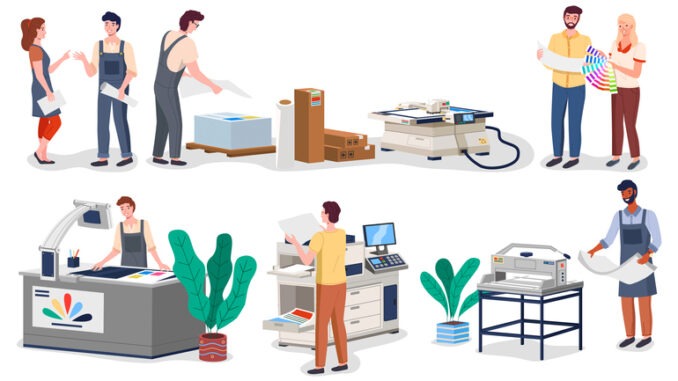
In the first of a series of features on sustainable print solutions, we look at how OEMs and vendors are satisfying customer demand for greater sustainability
Following the COP26 summit in Glasgow late last year, and a raft of government policies geared towards the country reaching net zero carbon emissions within the next 30 years, businesses are looking at ways they can become more sustainable, and many are looking within the office, including at their print solutions.
OEMs and vendors are responding to this demand, as Rod Tonna-Barthet, president and chief executive officer at KYOCERA Document Solutions (UK), explains. “Print businesses are making extensive efforts to embrace sustainability in every aspect of their operations. One way to do this is by manufacturing devices with close to 100% recyclable components, using already-recycled materials in production, and integrating as many long-life parts as possible into printers.
“More specifically, toners are also being designed with sustainability in mind. Toners with a lower fusing temperature – requiring less energy to print documents – are becoming more commonplace. Toner-lock systems are also hugely beneficial, as they ensure that users only install a replacement when the container is empty. Another idea is to use black toner containers for waste toner once they’re empty, meaning you don’t need a separate waste toner bottle.”
Rod adds that print companies are also changing their product packaging. “Ditching plastic and polystyrene packaging in favour of cardboard, where possible, can make a huge difference,” he says. “Where plastic packaging must be used – such as in bags to protect devices or components – ensuring the material is recyclable helps offset any environmental impact.”
However, it is about more than just the products, and many print businesses are embedding sustainable initiatives into their wider manufacturing practices. “These can range from maximising natural light in office
and factory spaces, in order to decrease electricity usage, to taking steps to reduce water usage in production,” Rod says. “It’s important to recognise that print sustainability requires a holistic approach, encompassing all areas of the business. Organisations that are on top of this are the ones that will be successful this year and into 2023.”
Sam Johnson, sustainability and organisational development manager at Brother UK, agrees. “It’s crucial that vendors are as sustainable as their solutions,” she says. “At Brother UK we’re 100% zero waste-to-landfill across our UK operations, and our specialist recycling and environment technology centre in North Wales has just secured carbon neutral status. This is helping us work towards our wider goal of becoming carbon neutral across the entire Brother group by 2050. Procuring tech from sustainable suppliers is going to be an even greater priority for firms, going forwards, and it’s up to vendors and partners to also be up to scratch.”
Longer lasting
There are various ways to reduce the environmental impact of printers, and one of these is to ensure they last longer. “We’re against the unsustainable practice of ‘planned obsolescence’, where products are designed to have a limited lifespan in order to drive sales,” says Sam. “Instead, we’re upgrading devices across our portfolio with greater duty cycles, reducing the volume of machines that need to be recycled or disposed of. Ultimately, technology that lasts longer creates less waste, allowing users to get more time and usage out of their printers.
Sam adds that acquiring tech and solutions through managed print services (MPS) further helps to improve sustainability by creating circular economies. “Devices can be refurbished and redeployed at the end of a contract with the help of modular replacements, or they can be recycled responsibly by vendors,” she says. “We’re making MPS more accessible to smaller businesses with the launch of PrintSmart Essential – a Netflix-style subscription service giving customers the benefits of print as a service under low commitment agreements.”
In addition, many companies are also turning to business inkjets as a more energy-efficient alternative to laser models as they look for opportunities to save energy, says Sam. “We’re investing in significant upgrades across our inkjet portfolio to support energyconscious customers at a time when other vendors have taken a step back from the inkjet market.”
Recycling importance
Sam is keen to highlight Brother UK’s free consumables recycling scheme that invites customers to return their used printer ink and toner cartridges for recycling at no cost. “This helps to reduce waste to landfill,” she says.
Phillip John, category manager – office, at Konica Minolta Business Solutions (UK) Ltd, also believes that recycling is important in the print sector. “Not just using recycled materials in printers, but also in things like bottles used for toner and even through developing toner that has a high level of ‘deinkability’which makes it easier to recycle the paper it’s used on – all of which Konica Minolta does.”
He adds that Konica Minolta operates the ‘Clean Planet Program’ for the collection of used consumables such as toner cartridges and bottles, photoconductor drums, and other pieces that are disposed of using environmentally sound processes. “Additionally, Konica Minolta’s office devices are built for long-life, and have a recyclable design, which is a requirement of the strict Blue Angel environmental label which nearly all our office devices have been awarded,” he says. “These devices are reused after their first use-cycle for another four or five years, and sometimes even longer.
“We also provide guidance to our partners and customers to help reduce unnecessary wastage, which includes the efficient programming of printing devices to minimise resource usage, for example, options such as Duplex, N-Up, Print Preview, blank page removal, User and Cost Management, overlay function, Public box, Personal box/Follow-me printing, and the specific use of recycled paper all help to significantly reduce waste, and use less ink, paper and energy resources.”


Be the first to comment